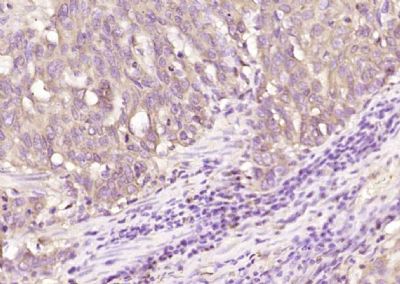ODZ3 Polyclonal Antibody
Purified Rabbit Polyclonal Antibody (Pab)
- 产品详情
- 实验流程
Application
| IHC-P, IHC-F, IF, ICC, E |
|---|---|
| Primary Accession | Q9P273 |
| Reactivity | Rat, Pig, Dog, Bovine |
| Host | Rabbit |
| Clonality | Polyclonal |
| Calculated MW | 300950 Da |
| Physical State | Liquid |
| Immunogen | KLH conjugated synthetic peptide derived from human TENM3 |
| Epitope Specificity | 1721-1850/2699 |
| Isotype | IgG |
| Purity | affinity purified by Protein A |
| Buffer | 0.01M TBS (pH7.4) with 1% BSA, 0.02% Proclin300 and 50% Glycerol. |
| SUBCELLULAR LOCATION | Membrane; Single-pass type II membrane protein.Cell projection, axon (By similarity). |
| SIMILARITY | Contains 8 EGF-like domains. Contains 5 NHL repeats. Contains 1 teneurin N-terminal domain. Contains 23 YD repeats. |
| SUBUNIT | Homodimer; disulfide-linked (Probable). |
| DISEASE | Note=Defects in TENM3 are a cause of microphthalmia, isolated, with coloboma (MCOPCB). Microphthalmia is a disorder of eye formation, ranging from small size of a single eye to complete bilateral absence of ocular tissues. Ocular abnormalities like opacities of the cornea and lens, scaring of the retina and choroid, cataract and other abnormalities like cataract may also be present. Ocular colobomas are a set of malformations resulting from abnormal morphogenesis of the optic cup and stalk, and the fusion of the fetal fissure (optic fissure). [SIMILARITY] Belongs to the tenascin family. Teneurin subfamily. |
| Important Note | This product as supplied is intended for research use only, not for use in human, therapeutic or diagnostic applications. |
| Background Descriptions | This gene encodes a member of the teneurin transmembrane protein family. The encoded protein may be involved in the regulation of neuronal development including development of the visual pathway. Mutations in this gene have been associated with microphthalmia and developmental dysplasia of the hip. [provided by RefSeq, Jan 2023] |
| Gene ID | 55714 |
|---|---|
| Other Names | Teneurin-3, Ten-3, Protein Odd Oz/ten-m homolog 3 {ECO:0000303|Ref.5}, Tenascin-M3, TENM3 (HGNC:29944) |
| Target/Specificity | Expressed in adult and fetal brain, slightly lower levels in testis and ovary, and intermediate levels in all other peripheral tissues examined. Not expressed in spleen or liver. Expression was high in brain, with highest levels in amygdala and caudate nucleus, followed by thalamus and subthalamic nucleus. |
| Dilution | IHC-P=1:100-500,IHC-F=1:100-500,ICC=1:100-500,IF=1:50-200,ELISA=1:5000-10000 |
| Format | 0.01M TBS(pH7.4) with 1% BSA, 0.09% (W/V) sodium azide and 50% Glyce |
| Storage | Store at -20 °C for one year. Avoid repeated freeze/thaw cycles. When reconstituted in sterile pH 7.4 0.01M PBS or diluent of antibody the antibody is stable for at least two weeks at 2-4 °C. |
| Name | TENM3 (HGNC:29944) |
|---|---|
| Function | Involved in neural development by regulating the establishment of proper connectivity within the nervous system. Acts in both pre- and postsynaptic neurons in the hippocampus to control the assembly of a precise topographic projection: required in both CA1 and subicular neurons for the precise targeting of proximal CA1 axons to distal subiculum, probably by promoting homophilic cell adhesion. Required for proper dendrite morphogenesis and axon targeting in the vertebrate visual system, thereby playing a key role in the development of the visual pathway. Regulates the formation in ipsilateral retinal mapping to both the dorsal lateral geniculate nucleus (dLGN) and the superior colliculus (SC). May also be involved in the differentiation of the fibroblast-like cells in the superficial layer of mandibular condylar cartilage into chondrocytes. |
| Cellular Location | Cell membrane {ECO:0000250|UniProtKB:Q9WTS6}; Single-pass membrane protein {ECO:0000250|UniProtKB:Q9WTS6}. Cell projection, axon {ECO:0000250|UniProtKB:Q9WTS6} |
| Tissue Location | Expressed in adult and fetal brain, slightly lower levels in testis and ovary, and intermediate levels in all other peripheral tissues examined. Not expressed in spleen or liver Expression was high in brain, with highest levels in amygdala and caudate nucleus, followed by thalamus and subthalamic nucleus |
Research Areas
For Research Use Only. Not For Use In Diagnostic Procedures.
Application Protocols
Provided below are standard protocols that you may find useful for product applications.
终于等到您。ABCEPTA(百远生物)抗体产品。
点击下方“我要评价 ”按钮提交您的反馈信息,您的反馈和评价是我们最宝贵的财富之一,
我们将在1-3个工作日内处理您的反馈信息。
如有疑问,联系:0512-88856768 tech-china@abcepta.com.























 癌症的基本特征包括细胞增殖、血管生成、迁移、凋亡逃避机制和细胞永生等。找到癌症发生过程中这些通路的关键标记物和对应的抗体用于检测至关重要。
癌症的基本特征包括细胞增殖、血管生成、迁移、凋亡逃避机制和细胞永生等。找到癌症发生过程中这些通路的关键标记物和对应的抗体用于检测至关重要。 为您推荐一个泛素化位点预测神器——泛素化分析工具,可以为您的蛋白的泛素化位点作出预测和评分。
为您推荐一个泛素化位点预测神器——泛素化分析工具,可以为您的蛋白的泛素化位点作出预测和评分。 细胞自噬受体图形绘图工具为你的蛋白的细胞受体结合位点作出预测和评分,识别结合到自噬通路中的蛋白是非常重要的,便于让我们理解自噬在正常生理、病理过程中的作用,如发育、细胞分化、神经退化性疾病、压力条件下、感染和癌症。
细胞自噬受体图形绘图工具为你的蛋白的细胞受体结合位点作出预测和评分,识别结合到自噬通路中的蛋白是非常重要的,便于让我们理解自噬在正常生理、病理过程中的作用,如发育、细胞分化、神经退化性疾病、压力条件下、感染和癌症。






